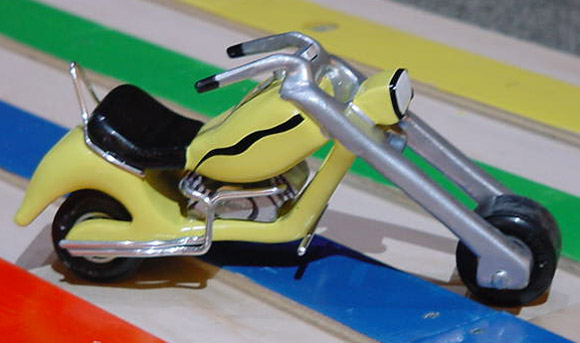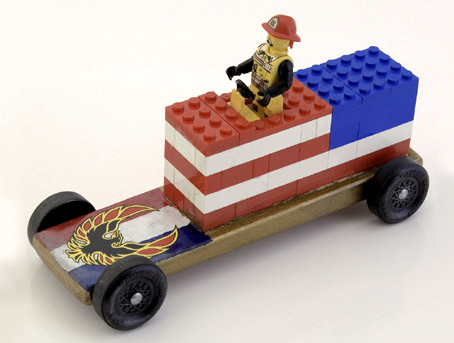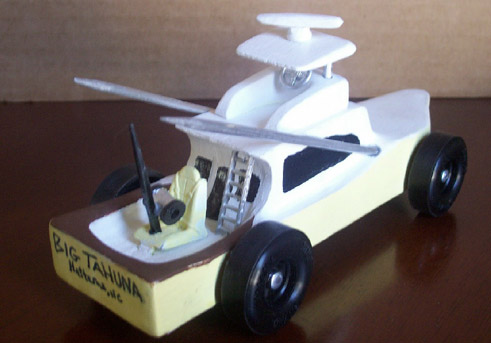– Feature Article – Top Fuel Cars: Wheel Bearings
– Pinewood Derby Car Showcase
– Memory – A Challenging Time
– Q&A
Top Fuel Cars: Wheel Bearings
(The first in a series of articles on cars that stretch the rules)
Virtually every pinewood derby rule set prohibits the use of bearings on wheels. However, occasionally a race occurs with rules that are relaxed enough to permit the use of ball bearings. Even if your race prohibits bearings, it’s always fun for a leader to have a ‘challenge’ car – that is, a car that you can challenge the kids to beat. Would ball bearings really provide a boost of speed, at least enough to keep the Cubmaster undefeated? Well, that is exactly what I set out to discover.
Wheel Bearing Selection
The first issue I had to solve was how to actually install bearings on a pinewood derby car. I first considered embedding the bearing in the car body, with the wheel pressed onto the axle shaft. After some experimentation, I switched this around such that the bearing was pressed into the wheel (see Figure 1). This simplified mounting the assembly on the car body, and allowed the use of a smaller bearing.
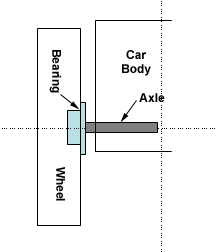
Wheel Bearings on Pinewood Derby Car
Next I had to select the wheel bearings. I chose to use a bearing which has 3/16 inch outside diameter (OD), and a 3/32 inch inside diameter (ID) (see Figure 2). This bearing has a flange to allow a more positive mounting with the wheel hub, and a stronger glue bond. I also chose a bearing without a seal, so that the bearings could be easily cleaned and lubricated. Seals are nice in that they keep dust out of the bearings, but they tend to require more force to turn, and cannot be easily lubed.
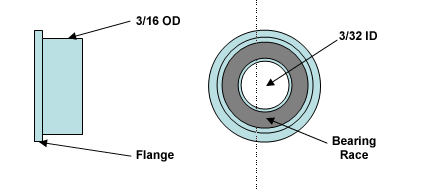
Wheel Bearing Features
Wheels
With a 3/16 inch OD bearing, the wheel bore must be sized to 3/16 inch (this is larger than the bore on a standard BSA wheel). To use these bearings the wheel hub is squared to the bore, and then the bore is enlarged to 3/16 inch. I used a lathe with a 3/16 inch bit to ream out a set of BSA wheels and a set of Outlaw wheels. This reaming could be done with a drill press, but likely the resulting bores would not be exactly centered on the wheel (leading to a bumpy ride).
Axles
Finding axles proved to be the biggest challenge. At the hobby shop I purchased several 3/32 inch rods of copper tubing, steel tubing, plastic tubing, and solid acrylic. If I had taken a set of digital calipers to the store, I could have saved some money. As it turned out “3/32 inch” does not necessarily mean the material measures 3/32 inch. In fact to be certain that the axles press snuggly into the bearings requires an axle with a fairly high degree of diameter accuracy. I ended up purchasing some 3/32 inch drill rod from an industrial supply store, and then cut it to the proper axle length.
Mounting the Bearings
First, the bearings were pressed onto the axle (Figure 3). This was started by hand, and then a drill press was used to provide the extra force to seat the bearing. I did ruin a bearing or two until I got the technique worked out.
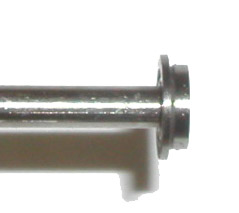
Axle pressed into Wheel Bearing
Next the bearings were cleaned in alcohol to make sure that no oil was present on the outside of the bearing (otherwise the glue would not bond. After the alcohol dried, the bearings were glued into the wheel bore with a little epoxy. Care must be taken to avoid getting glue into the bearing race (the channel that holds the ball bearings in place).
I then put a drop of oil into each bearing. I used Krytox 100, a very light weight oil. But NyOil II, SB10, or any other light weight oil would also work.
Finally, the bearing assembly was then pressed into the axle holes (Figure 4). I gapped the wheel bearing with a standard gap gauge, but I don’t believe the gapping is critical since the wheel doesn’t slide on the axle.
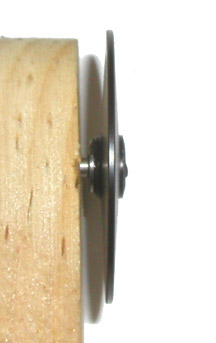
Final Assembly
Tests
I then ran 10 heats with the following configurations:
- Extended Wedge, BSA wheels, no bearings
- Extended Wedge, BSA wheels, with bearings
- Extended Wedge, outlaw wheels, no bearings
- Extended Wedge, outlaw wheels, with bearings
The results of the tests are shown in Figure 5 (slowest to fastest, left to right). Note that the BSA wheel results cannot be directly compared with the Outlaw wheel results, as the Outlaw wheel configuration was slightly lighter in weight due to the difference in wheel weight.
| Trial | BSA-No | BSA-Yes | Outlaw-No | Outlaw-Yes |
|---|---|---|---|---|
| 1 | 2.594 | 2.581 | 2.520 | 2.455 |
| 2 | 2.595 | 2.585 | 2.525 | 2.458 |
| 3 | 2.595 | 2.583 | 2.525 | 2.460 |
| 4 | 2.599 | 2.584 | 2.518 | 2.458 |
| 5 | 2.601 | 2.578 | 2.524 | 2.458 |
| 6 | 2.604 | 2.591 | 2.519 | 2.458 |
| 7 | 2.602 | 2.595 | 2.523 | 2.462 |
| 8 | 2.609 | 2.588 | 2.517 | 2.455 |
| 9 | 2.608 | 2.594 | 2.520 | 2.460 |
| 10 | 2.608 | 2.593 | 2.519 | 2.454 |
| Ave | 2.602 | 2.587 | 2.521 | 2.458 |
| Delta | -0.014 | -0.063 |
Figure 5
Heat Times
Observations
From Figure 5, the improvement when using bearings on BSA wheels is much less than when using bearings on Outlaw wheels. Likely this is due to the increased lane guide friction with BSA wheels. Since the bearings cannot reduce this friction (they only reduce wheel bore to axle friction), the improvement is much less. Although this was not tested, bearings should help more on longer tracks and in races where heavier cars are allowed.
So, if you need a car that will take on all comers, then go with a bearing car.
Pinewood Derby Car Showcase
Chopper: Scott Morris
This chopper car was built by Doug Kile. He carved the chopper from two Awana Grand Prix blocks glued together. The chopper didn’t run the track very well, as it kept falling over. But all the clubbers and parents thought the design was really cool!!! It just goes to show you, no design is impossible if you use your imagination.
Lego Fire Engine: Denise & Brendan Kelly
My son Brendan was very interested in Legos in 2002. Since 9/11 had just occurred and was such an important event, he found a way to represent the time, depict some patriotism, and also to honor the firefighters. By the way, the car fit all the specs for our race and was fast enough to move on to district.
Big Tahuna: Linda & Alex Duncan
This is my son Alex’s car for this year’s Awana Grand Prix. Although he builds his Cub Scout cars each year for speed, he wanted to try an interesting design for the Awana race. He designed the car based on the sport fishing boat we charter in Hatteras, North Carolina every summer – the ‘Big Tahuna.’ It was the first time we used a Dremel rotary tool to shape the car, and it worked great for this design. His car won 1st Place for design in his division.
Pinewood Derby Memory
A Challenging Time
My son Wyatt is currently 10 years old. In 2003, when he was seven years old and in his first year as a Tiger Scout, we experienced our first pinewood derby race. We consulted friends and family to obtain some tips. We were fortunate in that he took 3rd place and was able to move on to the District race. We learned a lot of tips at the District race and we were hooked. The Internet enabled us to find your website and monthly newsletter.
In 2004 he took 1st place and was undefeated as he headed to District race. With the assistance of your newsletter and our experience we continued to refine ideas and methods for his car. We kept a simple wedge design and decided to emphasize axle preparation. The strategy for my son and I continued to pay off – 2005 found him again undefeated. Wyatt and I shared a lot of good memories. We enjoyed discussing and drawing out the initial design of his car. We developed a routine and timeline that would guide us from cutting out the car to the final weight placement. We were both looking forward to the 2006 race.
Shortly after the 2005 pack race I was notified that I was being called to active duty in the United States Army. My wife and I sat Wyatt and his two sisters down in March of 2005 and explained to them that I would be leaving on April 18, 2005 to report for active duty for a 1-1/2 year tour of duty in Iraq. Obviously the 2006 pinewood derby race was not the topic of discussion. But before I left, I made notes of the do’s and don’ts that Wyatt and I had learned over the past years. I wasn’t sure what 2006 would bring us, so I wanted to ensure that there were some detailed plans written down that others could follow. Your newsletter and various tips were an integral part of those plans.
In January of 2006 I was able to take my two week leave. My wife and I surprised our children and I arrived home January 1. My wife had already informed me that the local pack had distributed the pinewood derby kits. During my two week R & R my son and I discussed the pinewood derby race that was scheduled to be held in March. With all of the stress and strain that my service in Iraq was causing I did not want to put any added pressure on my son by somehow making him feel obligated to enter the race. Our discussions led to a drawing for the design of the car. Wyatt opted for a more streamlined car design. So he and I retired to the work shop and in a matter of a 1/2 hour we had the rough cut for his racer finished. I reviewed with him the various sanding techniques that he would be using to get the car body in race shape.
I then ’employed’ two of Wyatt’s uncles to assist Wyatt with the car preparation. Uncle Mark has two older boys who were in scouting. He and his boys had also had success in making winning cars. Wyatt’s Uncle Jayme, his Godfather, also agreed to help. When I returned to Iraq, Wyatt and I were both excited about the upcoming March race. Uncle Jayme and his wife have two girls, and thus he had never experienced the making of a pinewood derby race car. Jayme took the lead on working with Wyatt and together they finished the car.
Race day arrived on March 13. I anxiously awaited the results. Iraq is 9 hours ahead of Central Standard Time, thus it was not until the early morning hours that I learned of the success of Wyatt and his Godfather. Wyatt took 1st place and was undefeated!
As I send you this letter, my tour of duty is coming to an end in Iraq. Iraq remains a country with many challenges ahead of it. However, among all of the turmoil in Iraq, the 2006 pinewood derby race will always hold a special place in our family’s memories. It was a time of great challenges for my wife and children. But it was also a time when a boy was able to face some fears and work on his car without his Dad. It was also a time for a Godfather to enjoy his Godson, and to not only build a pinewood derby car but to build a relationship and memories that will last a lifetime.
James O’Neil
Major United States Army
Camp Liberty
Abu Ghraib, Iraq
Editor’s Note: This memory was received April 27, 2006
Q&A
Do you know what MPH a fast BSA legal Pinewood Derby car can achieve on a 44 ft. aluminum track? I am thinking of making a wind tunnel.
Well, let’s assume that the starting section is 1 foot, and the braking section is 4 feet, so the actual distance is 39 feet. (If this is not the case, the numbers below can be readily changed to reflect the actual length).
This is 39 / 5280 ft/mile =0.007386 miles
If the car completes the distance in 3.5 seconds (this is a guess), then the time is:
3.5 / 3600 seconds/hour = 0.000972 hours
So the average miles per hour is:
.007386 / 0.000972 = 7.6 MPH
Of course the peak speed will be faster, but generally no more than 20 MPH
Regarding a wind tunnel, you can find out about the wind tunnel I made in Volume 5, Issue 9 – January 25, 2006 by Clicking Here.
I read someplace that placing the axles closer to the front and back of the car to extend the wheel base will improve performance. Is this true? And if it is, do you know what the measurements would be?
Extended wheelbase cars do tend to run faster than standard wheelbase cars because:
- The center of gravity can be placed further back on the car,
- The cars tend to go straighter,
- Axle holes can be used, which – if accurately drilled – simplifies alignment.
I recommend placing the axles at 11/16 inch in from the ends of the block. This places the edge of the wheels just slightly within the length of the block.
One of your contributors mentioned that his car got faster with each race. How is this accomplished, as ours slows down after several races?
Generally, using graphite or liquid lubes (such as NyOil II or Krytox 100) results in increasingly faster runs for several heats. The car’s performance then plateaus, and finally starts to slow down. If your car gets slower after each heat, then either:
- A non-optimum lube is being used (for example, silicon lubes have the fastest runs at the beginning and slow down each heat thereafter),
- An optimum lube is being used, but not applied in the best way, or
- The lube is broken in too much (thus, the fastest heats have already occurred).
Want Answers?
Do you have a pinewood derby-related question? If so, e-mail us your question.We answer all questions by e-mail, but not every question will appear in the Q&A section of the newsletter.
Back Issues
Are you a new subscriber, or have you missed some of the previous newsletters? Don’t miss out; all of the issues for Volume 5 through Volume 17 are posted on our web site.
Newsletter Contributions
We welcome your contributions. If you would like to contribute an article, a web site review, a speed tip, or a pinewood derby memory, please e-mail us.
Subscription Information
The Pinewood Derby Times is a free e-newsletter focused on pinewood derby racing. It is published biweekly from October through March.
If you haven’t already done so, please forward this issue to your pinewood derby friends. But please don’t subscribe your friends. Let them decide for themselves. Thanks.
If this newsletter was forwarded to you, why not subscribe to receive this newsletter. There is no cost, and your e-mail address is safe, as we never sell or share our distribution list.
To subscribe, send a blank e-mail to
pi*********************@*******st.com
You will receive a confirmation e-mail. Reply to the confirmation e-mail and you will start receiving the Pinewood Derby Times with the next issue.
Randy Davis, Editor, Pinewood Derby Times
E-Mail: in**@**************ty.com
(C)2018, Maximum Velocity, Inc. All rights reserved. Please do not reprint or place this newsletter on your web site without explicit permission. However, if you like this newsletter we grant permission, and encourage you to e-mail it to a friend.
Maximum Velocity disclaims any personal loss or liability caused by utilization of any information presented in this newsletter.
The Pinewood Derby Times is not specific to, and is not affiliated with the Boy Scouts of America, YMCA, Awana, or any other organization.
(R)Maximum Velocity is a registered trademark of Maximum Velocity, Inc.
(R)Pinewood Derby is a registered trademarks of the Boys Scouts of America.
(R)Awana is a registered trademark of Awana Clubs International.
All other names are trademarks of their respective owners.

